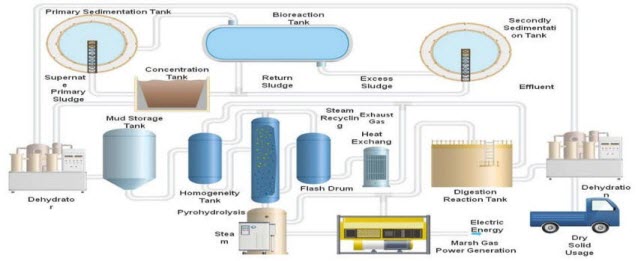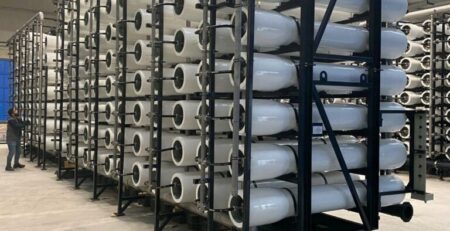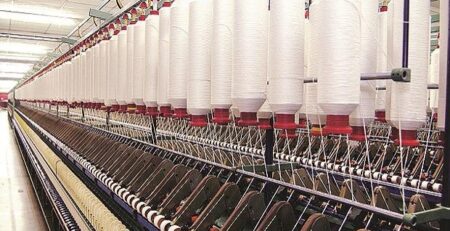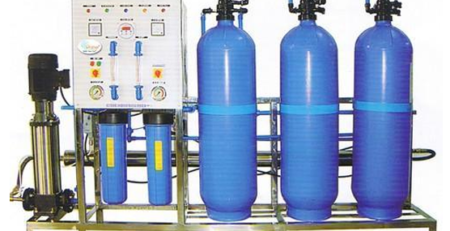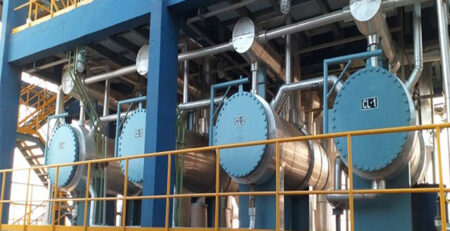The Ultimate Guide to Sludge Dewatering Equipment
Introduction to Belt Filter Press
Belt Filter Press is a sludge dewatering equipment that uses a series of filter belts and rollers to remove water from sludge. BFP is a continuous and automated process that operates on the principle of gravity dewatering. The sludge is fed into the BFP and passes through a series of rollers, which squeeze the water out of the sludge. The filtered water is collected and discharged, and the dewatered sludge is discharged as a cake.
Working Principle of Belt Filter Press
Belt Filter Press operates on the principle of gravity dewatering. The sludge is fed onto the top of the filter belt, and the belt slowly moves forward. The sludge passes through a series of rollers, which apply pressure to the sludge, squeezing out the water. The filtered water is collected and discharged, while the dewatered sludge forms a cake on the belt. The belt then passes over a series of additional rollers that apply more pressure to further remove the water. Finally, the dewatered sludge is discharged as a cake.
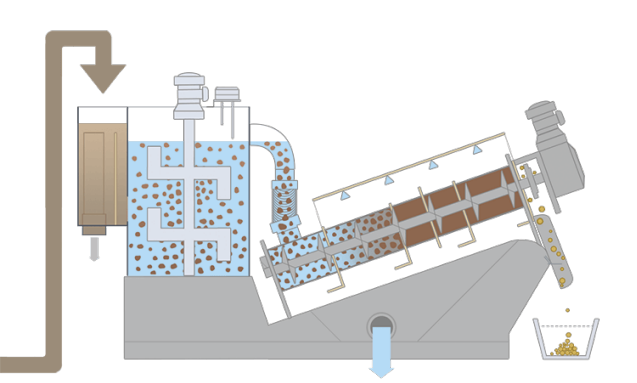
Types of Belt Filter Press
There are two types of Belt Filter Press:
-
Conventional Belt Filter Press
Conventional Belt Filter Press uses two filter belts and operates on the principle of gravity dewatering. The sludge is fed onto the top of the filter belt, and the belt slowly moves forward. The sludge passes through a series of rollers, which apply pressure to the sludge, squeezing out the water. The filtered water is collected and discharged, while the dewatered sludge forms a cake on the belt. The belt then passes over a series of additional rollers that apply more pressure to further remove the water. Finally, the dewatered sludge is discharged as a cake.
-
High-Pressure Belt Filter Press
High-Pressure Belt Filter Press is a modified version of the conventional BFP, which uses high-pressure rollers to apply more pressure to the sludge, resulting in higher water removal. The high-pressure rollers can apply up to 10 times more pressure than the conventional rollers, resulting in a higher cake dryness.
Advantages of Belt Filter Press
Belt Filter Press has several advantages over other sludge dewatering equipment, such as:
- Continuous and automated operation
- Low power consumption
- Low maintenance cost
- High solids capture rate
- Compact design
- Wide range of applications

Belt Filter Press vs. Other Dewatering Equipment
The belt filter press is a continuous operation dewatering machine that separates sludge solids and liquid from the wastewater. It uses a combination of gravity drainage, wedge-shaped zone, and pressure to remove water from the sludge. Compared to other dewatering equipment, such as centrifuges, screw presses, and plate and frame presses, the belt filter press has several advantages.
First, the belt filter press has a lower operating cost compared to other devices. It requires less power and maintenance, resulting in a lower overall cost of ownership. Second, the belt filter press produces drier cake solids, which reduces the volume and weight of the final sludge for disposal. Third, the belt filter press has a smaller footprint and requires less space for installation.
Factors Affecting Belt Filter Press Performance
The performance of the belt filter press is affected by several factors, including sludge characteristics, belt speed, pressure, and conditioning chemicals. The type of sludge, its concentration, and particle size distribution impact the dewatering performance. Sludge with a high concentration of fine particles requires a slower belt speed to ensure sufficient drainage.
The belt tension and pressure applied to the sludge also affect the dewatering performance. A higher belt tension and pressure can increase the dewatering efficiency but may cause belt blinding or excessive wear. Conditioning chemicals, such as polymers, can improve the dewatering performance by increasing the solids capture and reducing the moisture content of the cake.
Design and Construction of Belt Filter Press
The belt filter press consists of several components, including a gravity drainage zone, wedge zone, and pressure zone. The sludge is first fed onto the gravity drainage zone, where free water is removed by gravity. The sludge then moves to the wedge zone, where the solids are compressed and the remaining water is forced out. Finally, the sludge is pressed between two belts in the pressure zone, resulting in a drier cake.
The construction of the belt filter press is typically made of stainless steel, carbon steel, or plastic materials. The belts are made of synthetic materials, such as polyester, polypropylene, or nylon, and are designed to withstand the pressure and tension applied during the dewatering process. The belts are supported by a frame, rollers, and tensioning systems, which ensure proper alignment and tension.
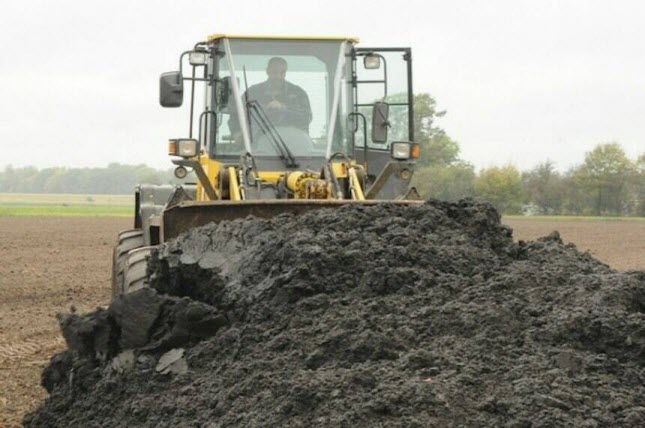
Operation of Belt Filter Press
The operation of the belt filter press involves several steps, including loading, pre-conditioning, gravity drainage, wedge zone compression, and pressure zone dewatering. The sludge is first loaded onto the belt filter press and mixed with conditioning chemicals to improve the dewatering performance. The sludge then moves through the different zones of the belt filter press, where the water is progressively removed.
The belt filter press is a continuous operation device, meaning that sludge is fed into the machine continuously, and the dewatered cake is discharged at regular intervals. The speed of the belts, pressure, and other parameters can be adjusted to optimize the dewatering performance based on the sludge characteristics.
Maintenance of Belt Filter Press
If you work in the wastewater treatment industry, you likely use a belt filter press to dewater sludge. Belt filter presses are reliable, efficient, and require little maintenance, but they still require regular upkeep to operate at peak performance. In this article, we will discuss the maintenance of belt filter presses, safety measures to follow, applications, and the future of these machines.
Understanding the Belt Filter Press
Before we dive into maintenance and safety measures, let’s briefly discuss what a belt filter press is and how it works. A belt filter press is a type of mechanical dewatering equipment that uses two belts to squeeze water out of sludge. The sludge is first conditioned with a polymer to enhance the dewatering process. Then, the sludge is fed into the machine, where it travels between two belts. As the sludge passes through, the water is forced out, leaving behind a solid cake. The cake is then discharged from the machine, and the water is sent to the wastewater treatment plant for further treatment.
Importance of Maintenance for Belt Filter Press
Regular maintenance is crucial for the optimal performance of a belt filter press. Neglecting maintenance can result in decreased efficiency, reduced throughput, and costly repairs. Maintenance activities should be performed on a regular basis to prevent equipment failure and extend the life of the machine.
Maintenance Checklist for Belt Filter Press
Here is a checklist of maintenance activities that should be performed regularly on a belt filter press:
Cleaning
The belt filter press should be cleaned regularly to prevent buildup of sludge and debris. The belts, rollers, and other components should be wiped down with a damp cloth.
Inspection
Inspect the belt filter press regularly for signs of wear and tear. Look for cracks, leaks, or other damage that could compromise the operation of the machine.
Belt Tension
Maintain proper belt tension to ensure that the belts are not slipping or sliding. Too much tension can cause premature wear, while too little tension can result in poor dewatering.
Lubrication
Lubricate the moving parts of the belt filter press to prevent friction and wear. Use the recommended lubricants and follow the manufacturer’s instructions.
Bearing Replacement
Replace bearings as needed to prevent equipment failure. Bearings can wear out over time and need to be replaced periodically.
Belt Tracking
Ensure that the belts are tracking properly and are not slipping or sliding. Improper belt tracking can cause premature wear and tear on the belts.
Filter Cloth Replacement
Replace filter cloths as needed to maintain proper dewatering performance. Over time, filter cloths can become clogged with sludge and need to be replaced.
Hydraulic System Maintenance
Maintain the hydraulic system to prevent leaks and ensure proper operation of the machine. Check the fluid levels and replace the filters as needed.

Safety Measures of Belt Filter Press
Safety measures for belt filter press are crucial to ensure the safety of the operators and prevent accidents or injuries. The following are some of the key safety measures that should be taken into consideration when working with a belt filter press:
- Personal Protective Equipment (PPE): Operators should wear appropriate PPE, such as gloves, eye protection, and respiratory protection, when handling sludge, chemicals, or operating the machine.
- Lockout/Tagout: The belt filter press should be locked and tagged out before any maintenance or repair work is performed to prevent accidental startup.
- Training: All operators and maintenance personnel should receive adequate training on the operation and maintenance of the belt filter press, as well as the safety measures and procedures.
- Guarding: The belt filter press should be equipped with appropriate guarding and safety interlocks to prevent access to moving parts and ensure safe operation.
- Emergency Stop: An emergency stop button should be easily accessible and clearly labeled to allow the operator to stop the machine quickly in case of an emergency.
- Ventilation: Proper ventilation should be provided to prevent the buildup of hazardous gases or fumes.
- Electrical Safety: Electrical components should be properly installed and maintained to prevent electrical hazards.
- Housekeeping: Good housekeeping practices should be implemented to prevent slip and fall accidents and reduce fire hazards.
By following these safety measures and procedures, the risk of accidents or injuries when working with a belt filter press can be minimized, ensuring the safety of the operators and a safe working environment.
Applications of Belt Filter Press
Belt filter presses are commonly used in wastewater treatment plants, industrial processes, and mining operations for dewatering sludge or slurries. Here are some of the key applications of belt filter press:
- Municipal Wastewater Treatment: Belt filter presses are widely used in municipal wastewater treatment plants for dewatering sludge generated during the treatment process. The sludge is fed onto the belt and the water is extracted, resulting in a drier, more compact sludge cake that can be easily transported and disposed of.
- Industrial Processes: Belt filter presses are also used in various industrial processes, such as paper mills, chemical plants, and food processing facilities, to dewater sludge or wastewater generated during the production process.
- Mining Operations: Belt filter presses are used in mining operations to dewater mining tailings and concentrate slurries, reducing the volume of waste material that needs to be transported and stored.
- Landfills: Belt filter presses can be used to dewater leachate generated from landfills, reducing the volume of waste that needs to be transported and stored.
- Agriculture: Belt filter presses are used in agriculture for the dewatering of animal manure, reducing the volume of waste and facilitating transportation and disposal.
- Oil and Gas Industry: Belt filter presses are used in the oil and gas industry for the dewatering of drilling mud and produced water, reducing the volume of waste and facilitating transportation and disposal.

Overall, belt filter presses have a wide range of applications in various industries and processes where dewatering of sludge or slurries is necessary. They offer a cost-effective and efficient method of dewatering, resulting in a drier, more compact waste material that is easier to transport and dispose of.
Future of Belt Filter Press
The future of belt filter press is promising, as the demand for efficient and cost-effective dewatering equipment continues to increase. Here are some of the key developments and trends that are shaping the future of belt filter press:
- Automation: The use of automation and advanced control systems in belt filter presses is expected to increase, allowing for more precise and efficient operation, as well as improved monitoring and maintenance.
- Energy Efficiency: The demand for energy-efficient belt filter presses is increasing, as operators seek to reduce their energy consumption and operating costs. New designs and technologies that reduce energy consumption and improve overall efficiency are expected to be developed and implemented.
- Environmental Protection: Belt filter presses are being designed and developed with a focus on environmental protection, including the reduction of greenhouse gas emissions, the use of sustainable materials, and the minimization of waste and water usage.
- Improved Performance: Manufacturers of belt filter presses are investing in research and development to improve the performance and reliability of their equipment, including the development of new materials and designs that enhance dewatering efficiency and reduce maintenance requirements.
- Customization: Belt filter presses are becoming more customizable, allowing operators to tailor the equipment to their specific needs and applications, resulting in improved efficiency and performance.
Overall, the future of belt filter press is bright, with ongoing developments in technology, automation, and customization that will continue to improve efficiency and performance while reducing costs and environmental impact.

FAQs on Belt Filter Press
Q: What types of sludge can be dewatered using a belt filter press?
A: Belt filter presses can be used to dewater a variety of sludge types, including municipal wastewater sludge, industrial sludge, mining tailings, and agricultural waste.
Q: How does a belt filter press compare to other types of dewatering equipment?
A: Compared to other types of dewatering equipment, such as centrifuges or screw presses, belt filter presses are generally more cost-effective, have lower operating and maintenance costs, and are capable of dewatering a wider range of sludge types.
Q: What are the key factors that affect the performance of a belt filter press?
A: Some of the key factors that affect the performance of a belt filter press include sludge type and characteristics, feed rate, belt speed, and pressure applied to the sludge.
Q: How often does a belt filter press need to be maintained?
A: The frequency of maintenance for a belt filter press depends on several factors, including the specific design and operating conditions. However, regular maintenance, such as cleaning and inspection of the belts and rollers, is recommended to ensure optimal performance and prevent equipment failure.
Q: What safety measures should be taken when operating a belt filter press?
A: Operators of belt filter presses should be trained on proper safety procedures, including the use of personal protective equipment, lockout/tagout procedures, and safe handling of chemicals and equipment. It is also important to regularly inspect and maintain the equipment to prevent accidents and equipment failure.

